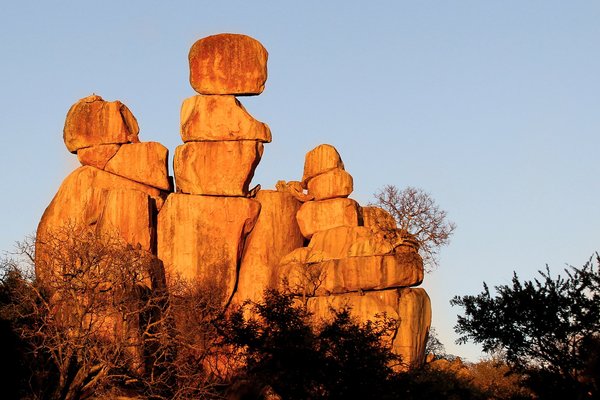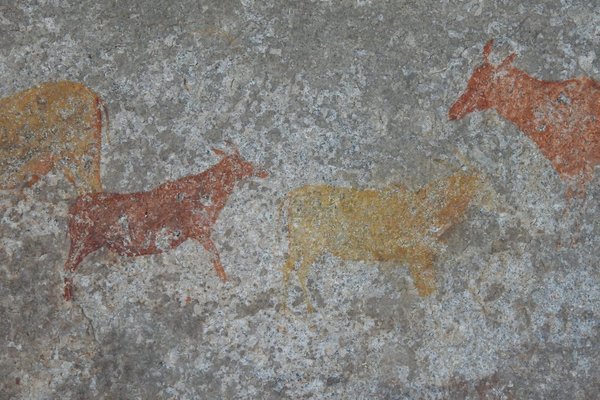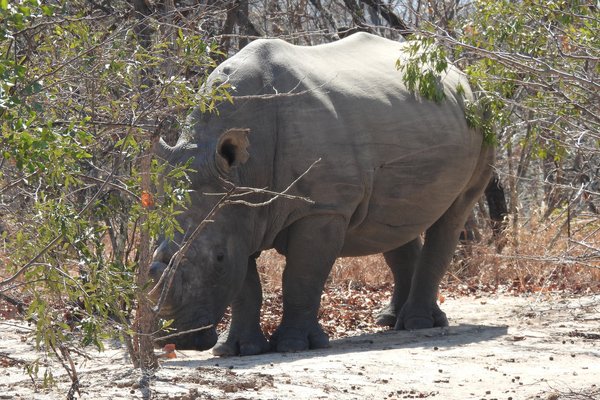Zimbabwe
Matobo Hills
The Matobo Hills comprise a living cultural landscape where people have interacted for over 100.000 years with the landscape, notably via rock paintings.
There are around 700 known sites with some 20.000 paintings. They date from the late Stone Age and the Iron Age, the oldest are 13.000 years old. Shrines and sacred places connected with the high God of the oracular cult Mwali are still in use.
Community Perspective: the Matobos offer a variety of sights, including several signposted caves with rock art and natural features such as distinct granite boulders and a game park area most notable for its reintroduced black and white rhinos.
Site Info
Official Information
- Full Name
- Matobo Hills (ID: 306)
- Country
- Zimbabwe
- Status
-
Inscribed 2003
Site history
History of Matobo Hills
- 2003: Inscribed
- Inscribed
- 1984: Deferred
- ICOMOS positive but dossier lacks justification - needs resubmission
- Type
- Cultural
- Criteria
- iii
- v
- vi
Links
- UNESCO
- whc.unesco.org
- Official
-
- zimparks.org.zw — Matobo National Park
- Related
-
- matobo.org — Matobo Conservation Society
- online.wsj.com — Great cave of Inanke
- en.wikipedia.org — Link
All Links
UNESCO.org
- whc.unesco.org — whc.unesco.org/
Official Website
- zimparks.org.zw — Matobo National Park
Related Resources
- matobo.org — Matobo Conservation Society
- online.wsj.com — Great cave of Inanke
- en.wikipedia.org — Link
News Article
- Nov. 30, 2024 science.org — Drought imperils Zimbabwe’s ancient rock art, spurring efforts to preserve and date it
- June 1, 2009 vancouversun.com — Matobo endangered due to neglect and dwindling tourist numbers
Community Information
- Community Category
- Archaeological site: Rock Art
- Cultural Landscape: Associative
Travel Information
Recent Connections
-
Bantu peoples
related to rituals of the Shona and Nde…
-
Foreigner prices
The national park charges 15 USD for in… -
Built in the 4th century
earliest paintings
Connections of Matobo Hills
- Individual People
-
-
Radziwill Family
Catherine Radziwill (1858-1941) was a stalker of and even claimed to be married to Cecil Rhodes, who is buried in Matabo Hills -
Cecil John Rhodes
"Cecil Rhodes, Leander Starr Jameson, and several other leading early white settlers....... are buried on the summit of Malindidzimu, the 'hill of the spirits'" (Wiki) Called World's view" by Rhodes it was his chosen burial location and is marked by a memorial
-
- Trivia
-
-
Built or owned by British
Rhodes Memorial etc -
Largest cultural WHS
205,000 ha
-
- History
-
-
Assassinations
Assassination of Mlimo by Frederick Russell Burnham in one of the Matobo caves in 1896 -
Bantu peoples
related to rituals of the Shona and Ndebele peoples
-
- Ecology
-
-
Over 300 bird species
The present checklist includes 406 species (Matobo Conservation Society)See matobo.org
-
Granite rock formations
See en.wikipedia.org
-
Hippos
In Matobo National Park -
Ratites
common ostrich -
Rhino habitat
"Matobo boasts various animal and bird species including black and white rhinos" (official website) -
Inselbergs
"The landscape is visually and ecologically distinguished from the surrounding dry savannah. A profusion of distinctive granite landforms, densely packed into a comparatively tight area, rise up to form a sea of hills. Their forms have resulted from the varied composition and alignment of the granites, which responded differently to millions of years of weathering, leaving inselbergs (large individual vertical rocks), kopjes, crenellated ridges, dwalas or hump-backed domes, and what look like randomly heaped boulders." (AB eval) -
Eagles
Verreaux's eagle (commonly named Black eagle in Southern Africa): "Matobo National Park contains the highest concentration of black eagles, and breeding pairs of these birds, worldwide." (official website)See en.wikipedia.org
-
- World Heritage Process
-
-
Cultural sites rejected for Natural criteria
The minutes of the Bureau of 1984 state that the site had been reviewed by both ICOMOS AND IUCN (which seems to imply that it must have been nominated on both Natural and Culturla ciriteria -the concept of "Cultural Landscape" wasn't then accepted by UNESCO). ICOMOS had been positive regarding the rock art and Zimbabwe was asked to resubmit with greater clarity regarding both the natural and cultural criteria. See page 16See whc.unesco.org
-
Ten years or more to inscribe
1984-2003
-
- Religion and Belief
-
-
Taboo
"Through a system of taboos and cultural norms that prohibit desecration, the long-standing intangible heritage of indigenous traditional religious beliefs and practices are still instrumental in the preservation of the tangible heritage." (Integrity statement)
-
- Human Activity
-
-
Pictographs
"The Matobo Hills have one of the highest concentrations of rock art in Southern Africa dating back at least 13,000 years. The paintings illustrate evolving artistic styles and also socio-religious beliefs. " (OUV) -
Hunter-gatherers
The authenticity of the hunter-gatherer and a few agriculturist rock paintings in the Matobo Hills area has been widely confirmed. (official description) -
San
"San (Bushmen) lived in the hills about 2,000 years ago, leaving a rich heritage in hundreds of rock paintings. " (wiki)
-
- Constructions
-
-
Tombs
"Graves of King Mzilikazi who formed the Ndebele nation and Cecil Rhodes who led European settlers into the country are both within the nominated area."
-
- WHS on Other Lists
-
-
World Monuments Watch (past)
Matobo Hills Cultural Landscape (2018)See www.wmf.org
-
- Timeline
-
-
Built in the 4th century
earliest paintings
-
- Visiting conditions
-
-
Foreigner prices
The national park charges 15 USD for international vistors, 12 USD for regional and 4 for locals.
-
News
- science.org 11/30/2024
- Drought imperils Zimbabwe’s ancien…
- vancouversun.com 06/01/2009
- Matobo endangered due to neglect a…
Recent Visitors
Visitors of Matobo Hills
- Alexander Barabanov
- Ali Zingstra
- A. Mehmet Haksever
- AmyAbroad
- amychemu
- Ask Gudmundsen
- Atila Ege
- Bram de Bruin
- Carlo Medina
- ctravel
- del
- Dolemite92
- Ellen Nielsen
- Els Slots
- Erfe91
- Eva Kisgyorgy
- Fan Yibo
- Felicité
- FS
- Gernot
- giulio25
- Iain Jackson
- janameerman
- Jarrod_Byham
- Jon Opol
- Ken DJ
- Lameduck99
- Liamps91
- Luis Filipe Gaspar
- Malgorzata Kopczynska
- marcel staron
- Nihal Ege
- Paul Schofield
- Peltzi
- Philipp Leu
- Priyaranjan Mohapatra
- Randi Thomsen
- Roman Bruehwiler
- Rosemary
- Solivagant
- stephhollett
- Svein Elias
- Tatiana Nikulnikova
- Thomas Buechler
- Thomas van der Walt
- Wojciech Fedoruk
Community Reviews
Show full reviews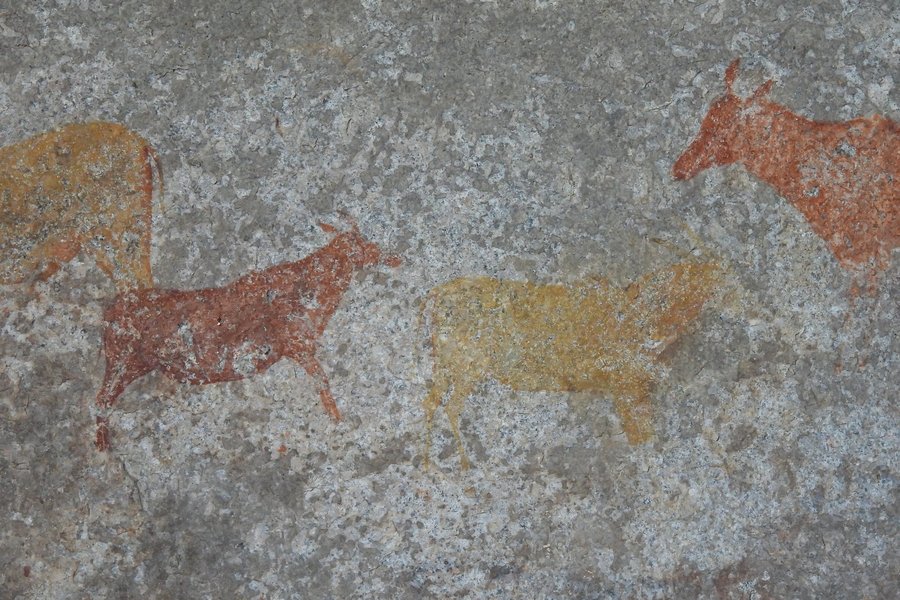
The OUV of Matobo Hills is a bit hard to grasp, but it boils down to the meaning this landscape had for the San hunter-gatherers (Stone Age, Iron Age) and the Ndebele nation (from the 19th century onwards). Nowadays, most tourists come here for the Rhinos and the Rock Art. I visited for 1.5 days as part of a small nature group tour (4 pax). We stayed overnight at the recommended Rowallan Camp, a small ‘glamping’ site with self-catering amenities just inside the park’s borders.
My 3 Australian tour mates were surprisingly smitten by the Matobo’s distinct landscape of rocky boulders – something that they could have observed very well at home, I think. At sunrise and sunset, it provides a picturesque setting, as do the neat bundles of hay waiting to be picked up that have been gathered during the day by female workers. There is some overflow of cattle from neighbouring areas into the park and several fires had encroached as well when we were there.
For the Rock Art, we went to Nswatugi Cave and Bambata Cave. The road system in Matobo has severely deteriorated over the years and one now needs a 4WD to get around properly (there’s a paved road that crosses it, but you won’t see much from there). Nswatugi was the easiest of the two to get to by car; its access road has only one nasty stream to cross. The paintings are in a rock shelter about a 15-minute walk uphill. …
Keep reading 0 comments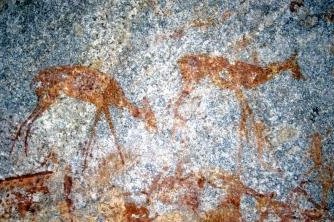
The Matabo Hills are inscribed as a “Cultural Landscape” - A somewhat opaque concept which can mean everything or nothing but often seems to mean that no single structure or natural site is worth inscribing but that the whole in some way is greater than the sum of the parts in representing a way of life! Indeed the relatively small area of the Matabos does offer a variety of sights
a. Some quite striking (if nor outstanding) scenery characterised notably by “Kopjes” – strangely shaped weathered granite outcrops often in the form of “castles” or huge “marbles” balanced on top of each other
b. A game park area which is full of reintroduced animals and, in terms of the whole gamut of African wildlife parks, rather “tame”
c. At “World’s View” outcrop the “White Colonial” memorials of Rhodes Grave and the Shangani Patrol (in memory of a group of white soldiers wiped out by the Ndebele in 1893).
d. Shrine caves of the Mwari Cult which are taboo to visitors
e. A number of caves or overhangs which can be visited and contain Rock paintings whose age is still a matter of some conjecture but were done by Stone and/or Iron age hunter gatherers.
Somehow all these aspects (including the Colonial memorials!) are credited in the inscription. Given time to explore and/or access to appropriate wildlife expertise the area would no doubt repay more in-depth exploration than is possible during a quick “tourist visit”. …
Keep reading 0 comments
